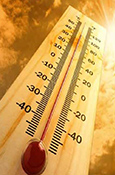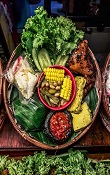Prepping for Monsoon
Prepping for Monsoon
 Paper boats, petrichor, umbrellas are some terms that are associated with a rainy day. Monsoon is one of the most important seasons in our country. From renewing the flora to increasing the groundwater level, monsoon is vital and life-sustaining. The season offers abundant benefits in the form of increased food production of crops that are dependent on the rainfall, generation of electricity (hydroelectricity) and development of the economy.
Paper boats, petrichor, umbrellas are some terms that are associated with a rainy day. Monsoon is one of the most important seasons in our country. From renewing the flora to increasing the groundwater level, monsoon is vital and life-sustaining. The season offers abundant benefits in the form of increased food production of crops that are dependent on the rainfall, generation of electricity (hydroelectricity) and development of the economy.This apart, the onset of monsoon increases the susceptibility to disease and, utmost care should be taken to stay healthy.
Here are some do’s and don’ts to stay safe this monsoon.
Do’s
-
Increase your intake of Vitamin C
Monsoon makes people vulnerable to diseases. Doctors often recommend increasing the intake of Vitamin C to keep illness at bay. Vitamin C is an immune booster which reduces the severity and duration of cold, flu and other infections.
-
Eat a healthy, balanced diet
Ensure you consume more healthy food during monsoon. A healthy diet will not only keep you fit, but will also reduce your chances of falling ill. Ingredients like garlic, ginger, turmeric and pepper are beneficial during the rainy season. It is advised to consume boiled or lukewarm water, if not a purified one.
-
Always carry an umbrella or a raincoat
It is advised to carry an umbrella or a raincoat whenever you step out, to avoid getting drenched.
-
Use naphthalene balls to reduce the risk of fungus
The monsoon climate makes the cupboards and drains susceptible to fungus. Naphthalene balls are chemical pesticides used to reduce the risk of fungus arising out of dampness.
-
Use a mild antiseptic while bathing
Antiseptic liquids help to prevent the growth of disease-causing microorganisms. Adding them to the water while taking bath helps to kill the microorganisms present on the skin.
Don’ts
-
Avoid getting wet in the rain
It is advised to take shelter whenever it rains. Getting drenched in rain can lead to illness/infections.
-
Avoid wearing damp clothes

Monsoon and dampness go hand in hand. It is advised to change into dry clothes immediately after getting wet in the rain. Wearing damp clothes increases the chances of bacterial/fungal infections.s
-
Do not allow water stagnation in/around residence
Water stagnation is a common issue during the monsoon. Stagnated water creates a breeding site for the mosquitoes. This again results in diseases like malaria or dengue.
-
Do not consume food from the roadside
Avoid consuming food from roadside as there are high chances of water contamination which can result in fever, throat infection and typhoid.
-
Avoid walking in dirty water
Avoid walking in dirty water, as such puddles are prone to contain bacteria which can lead to a variety of skin infection.
Illness to look out for:
-
Cold and flu
Cold is one of the most common occurrences during monsoon. It is highly contagious as the virus spreads through the air and affects the respiratory system. Symptoms often involve runny nose, body pain, sore throat and fever. Consuming fruits and vegetables rich in Vitamin C will help keep infections at bay.
-
Malaria
Malaria is transmitted by the female Anopheles mosquito. The symptoms resemble that of flu and it is advised to consult a doctor at the earliest.
-
Cholera
It is caused by contaminated food, water and poor hygiene. The common symptoms of cholera are severe diarrhea, vomiting, dehydration and muscle cramps.
-
Dengue
Dengue is caused by a virus and is carried by the mosquito. Fever, body pain, joint aches and rashes on the body are the symptoms. Precaution can be taken by keeping the surroundings clean and protecting oneself from mosquito bites.
-
Typhoid
Typhoid is another disease caused by contaminated water and food. It is caused by the Salmonella bacteria and includes symptoms like high fever, abdominal pain, headache and nausea. Precaution can be taken by avoiding roadside food.
- Diarrhoea and Jaundice
Consuming food from unhygienic places can affect the digestive system and lead diarrhea or jaundice. Weakness, vomiting and liver dysfunction are the symptoms of jaundice. to
-
Skin infection
Fungal and bacterial infections spread easily during the monsoon. Care should be taken to avoid walking in dirty water and staying in damp clothes. Precaution can be taken by wearing waterproof shoes, carrying an umbrella and by using antiseptic liquids.
-
Hepatitis A

hepatitis is caused by contaminated food and water. It includes symptoms like fever, rashes on the skin and vomiting. Maintaining proper hygiene can reduce the risk of this disease.
-
Gastroenteritis
Gastroenteritis/food poisoning are quite common during monsoon. It is an intestinal infection with symptoms like diarrhea, cramps, vomiting and fever. Precaution can be taken by consuming plenty of fluids, getting good amount of rest and maintaining proper hygiene.
-
Chikungunya
It is a viral infection transmitted by Aedes mosquito. The symptoms include fever, joint pain, fatigue, headache and muscle pain. Keeping the surrounding clean and preventing stagnation of water are some ways to keep the disease at bay.
Despite the illness that monsoon brings along, it is one of the most vital seasons in country, and can be made safer by taking certain precautions.our





















